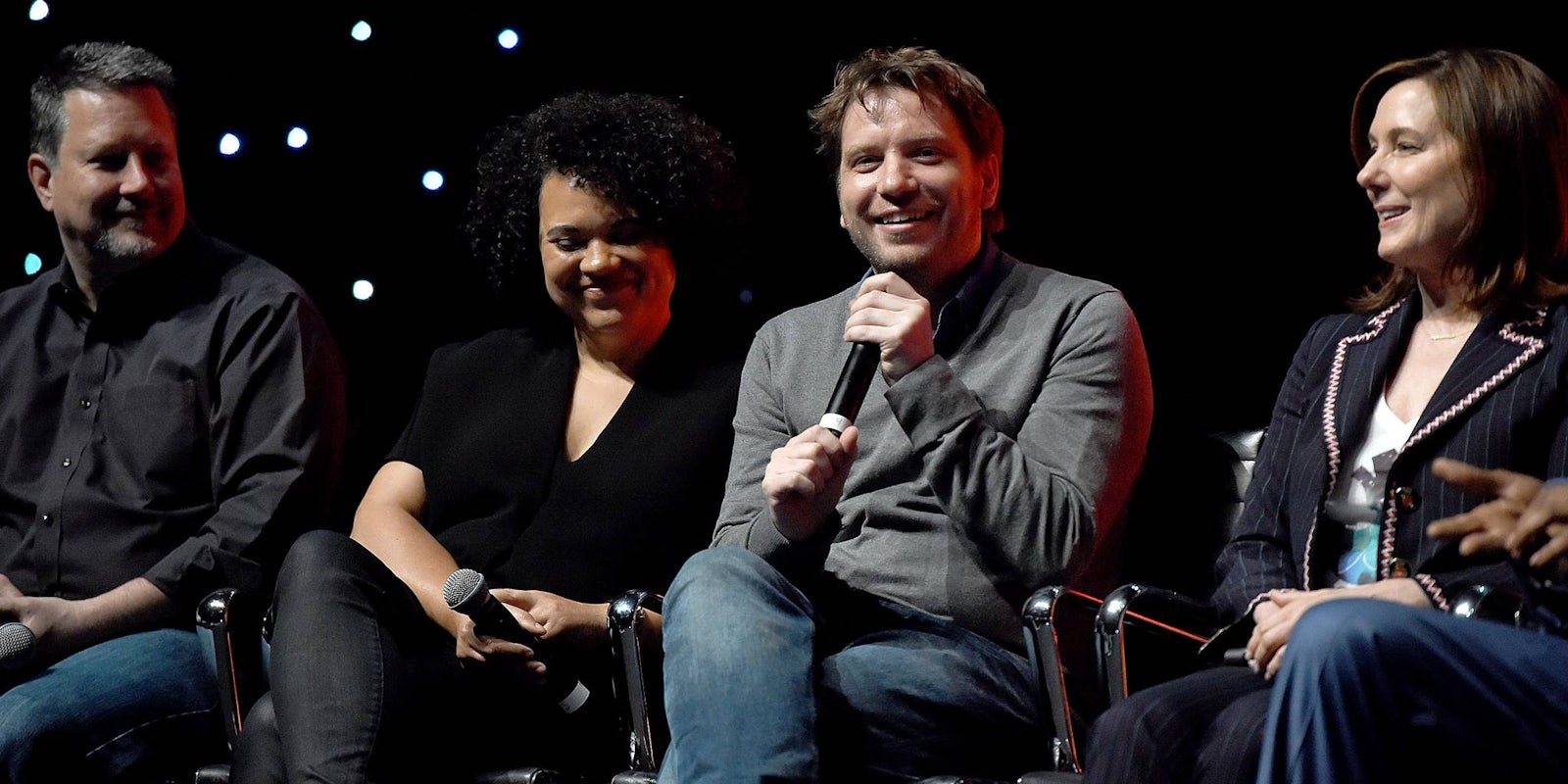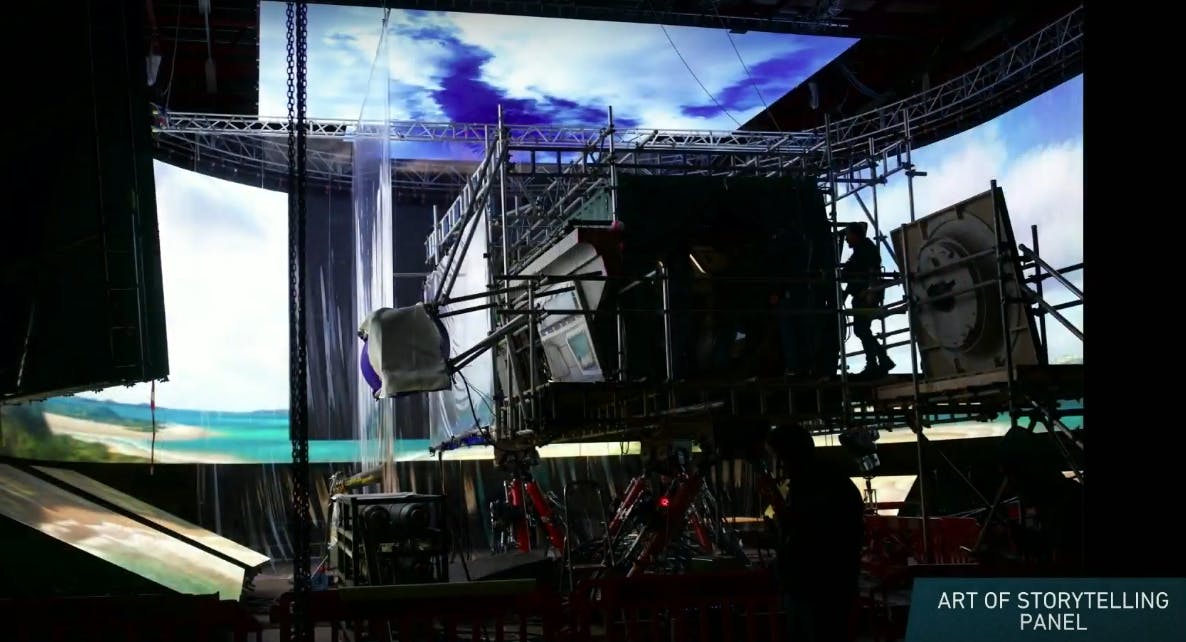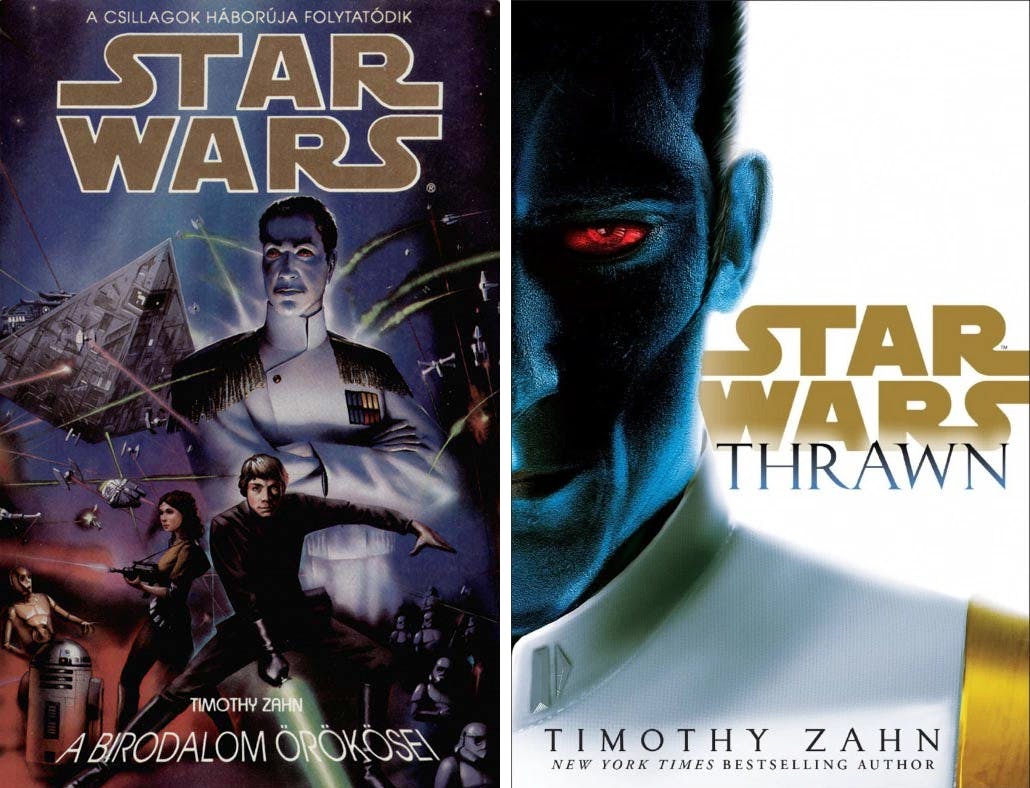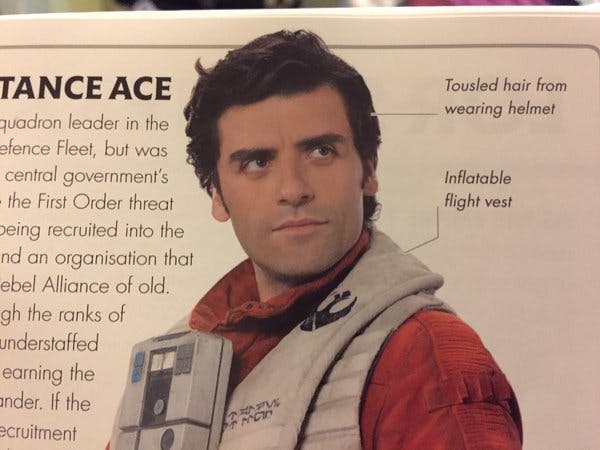In this new era of corporate storytelling, Marvel Studios is seen as the gold standard for multi-franchise entertainment. Yet at Star Wars Celebration this year, I came to realize that someone else was quietly outstripping them from behind the scenes: the Lucasfilm Story Group, another Disney offshoot.
Most Star Wars viewers are at least vaguely aware of the creative minds behind the new movies: J.J. Abrams, screenwriters Lawrence Kasdan and Michael Arndt, upcoming directors Gareth Edwards (Rogue One) and Rian Johnson (Episode VIII), and Lucasfilm president Kathleen Kennedy. Like any Hollywood production, they’re backed up by an army of execs and technicians, but unlike the typical view of blockbuster filmmaking, the idea of studio “interference” isn’t necessarily perceived as a negative.
You often hear people comparing the Lucasfilm Story Group to the Jedi Council, the keepers of sacred knowledge. Formed by Kathleen Kennedy in 2012, the Story Group’s job is to make sure every aspect of Star Wars canon remains aligned, from major plot twists to obscure factoids about planets that never appear onscreen. Some story arcs are planned years in advance, and the Story Group work with writers and filmmakers to develop new ideas for the franchise. Rogue One was actually pitched to them by Industrial Light and Magic’s Chief Creative Officer John Knoll, his first story credit after decades of work in visual effects.
Three major players from the Story Group appeared at Star Wars Celebration last week. Lucasfilm executive Kiri Hart—oft compared to Marvel’s Kevin Feige—appeared alongside Kathleen Kennedy and Gareth Edwards at the convention’s headlining Rogue One panel. Leland Chee maintains the Holocron, a ferociously detailed database of Star Wars lore, named after an information storage device from the movies. And Pablo Hidalgo works with a web of authors to keep Star Wars canon in check—as well as being a constant presence on Twitter, debunking rumors and teasing the fans.
https://twitter.com/pablohidalgo/status/754469311067095040
Because so many aspects of the franchise are developed in-house (sometimes literally, due to the prominence of George Lucas’s Skywalker Ranch and Lucasfilm’s San Francisco HQ), the Story Group’s creative oversight provides a direct link between seemingly disparate departments.
In some ways, Lucasfilm feels more like a tech company than a movie studio. For instance, its virtual reality offshoot ILMxLAB had a direct influence on Gareth Edwards’ work on Rogue One. During one of Celebration’s behind-the-scenes panels, Lucasfilm CTO Rob Bredow described building a spaceship rig for the movie, the kind of big-budget operation where actors can be flung around with accurate scenery in the background, adding realism to their performances.
“There were some questions about how it was going to be used… so we put a virtual reality headset on Gareth, put him in a primitive model of the ship, and he could look around the door, look to see the engine was. And actually in that case, in the first five minutes, he was like ‘We need to pull the engine two feet forward. Can we make this door a little bit wider, so I can get this shot when I go over the shoulder of the guy who’s got the gun?’ Five minutes into the experience he said, ‘This is so much better in real life!’”
By real life, he meant virtual reality.
As the first Star Wars spinoff, a lot has been made of how Rogue One might differ from the earlier movies, especially due to Edwards’ filmmaking style. The props and costumes follow a darker aesthetic, but the main difference is the way Edwards uses the camera, with techniques Kathleen Kennedy touted as “immersive.” For some scenes, he set up a 360-degree set where crew members had to dress as extras in case they were caught in shot. Other background performers were told to go about their daily business for long periods of time, fixing spaceships or cooking dinner as the lead actors immersed themselves in the environment. (This was also where the 3D scanners came into play, with every extra being scanned for future reference alongside the lead actors.)
Whether this pays off remains to be seen, but you get the impression that while Rian Johnson and J.J. Abrams were framed as auteur hires, they’re more like cogs in the machine. There’s a thriving ecosystem at work already, and filmmakers are guided at every level by Lucasfilm’s technical departments, hand-in-hand with the Story Group.
Alongside the more corporate end of Lucasfilm’s presence at Celebration, the Story Group ties into the most obsessively detail-oriented side of Star Wars fandom. Because unlike superhero comics, whose canon is extremely malleable, or Star Trek‘s myriad alternate timelines and silly one-off episodes, there’s only one official Star Wars canon. And it was born in 2014.
From a fandom perspective, the Story Group put itself on the map by torpedoing the Expanded Universe (EU), a vast network of tie-in materials that populated the Star Wars franchise for decades. Along with stories filling in the time between and after the movies, it introduced beloved characters like Grand Admiral Thrawn and Mara Jade Skywalker. Then in April 2014, Lucasfilm decided it was too unwieldy to link with the upcoming slate of movies. The EU was declared uncanonical, making way for a new universe encompassing episodes I-VI, the two animated series, and everything that came after April 2014. Now, everything goes through the Story Group, which provides background material and steers writers away from topics that will be covered in other corners of the franchise.
Geek franchises are fueled by a constant conflict between the desire for new material, and fandom’s wariness of anything that seems too new. Fans of Doctor Who and superhero comics experience this kind of seismic change every few years, and J.J. Abrams made waves when he destroyed Vulcan in his 2009 Star Trek movie. The death of the EU was considerably more controversial.
It’s easy to see why people were pissed—decades of lore from Star Wars comics and novels got suddenly erased from the canon—but after two years, it’s also obvious why that decision was necessary. Unlike Marvel Studios, which has recently suffered creative conflicts between Disney, Marvel, some filmmakers, and many members of its fanbase, Lucasfilm’s control seems absolute—and generally well-received. The new Star Wars canon is appropriately deep, but is still more accessible to new fans. (Although to be fair, the new franchise is still in its larval stages. Who knows what will happen with Episode VII and beyond.)
At one of the two Celebration panels I attended about Star Wars encyclopedias (yes, there were two), the Story Group’s Pablo Hidalgo and Leland Chee spoke about fact-checking the tiniest of canonical details for public consumption. Their biggest hits are the “visual dictionaries” of photos and illustrations from the movies, accompanied by short, kid-friendly blurbs of background information.
The two DK Publishing employees working on The Force Awakens dictionary were secluded in what they described as a “closet” to avoid any spoiler leaks, while Hidalgo cut out the middleman by writing the text himself. This included cute details like the viral image of Poe Dameron‘s “tousled hair,” an official canonical fact. (Apparently they had to include a fact at the top of the page, for layout purposes.)
Star Wars canon is treated like a field of academic study. If you’re writing a children’s book that mentions the length of Jar Jar Binks’s tongue, you don’t just make up a number. You check with Leland Chee at the Holocron, and if he doesn’t already have the right information, you work it out.
For author Cole Horton, that meant reenacting a scene from The Phantom Menace where Jar Jar sits down for a meal at Anakin Skywalker’s house. When Jar Jar tries to grab some fruit with his tongue, Qui-Gon Jin grabs it, giving a clear illustration of tongue length. Cole Horton’s long-suffering wife had to help with a real-life reenactment at their dinner table, which eventually resulted in him deciding Jar Jar’s tongue was one meter long—something he admits he probably could’ve guessed.
But that’s Star Wars canon for you. If you can’t find the specific information cited elsewhere, you need to dig deep and take it seriously. The most obscure ephemera could become important decades down the line—like the extra who appeared for about one second in The Empire Strikes Back carrying an ice cream maker under one arm, and who somehow ended up becoming a cult figure with an extensive biography.
This flavor of obsession is a hallmark of geek culture, but it’s also baked into the creative process of the entire franchise. While George Lucas was no great shakes as a screenwriter, the original trilogy emphasized sound design, concept art, costumes and music to an extent that simply doesn’t happen with most blockbuster movies. The new films are following in that legacy, but a strong guiding force is necessary to keep everything together.
The Story Group’s influence is everywhere, from the design of star maps in spinoff books to the diverse casting of the new movies—almost certainly stemming from the input of Kathleen Kennedy and Kiri Hart. The question now is how long this ecosystem can thrive. Other studios have hit serious problems trying to balance innovative creators with big-budget franchise properties. On the other hand, no other company has the same level of control as the Lucasfilm Story Group, which benefits from having an executive team full of lifelong Star Wars fans.



